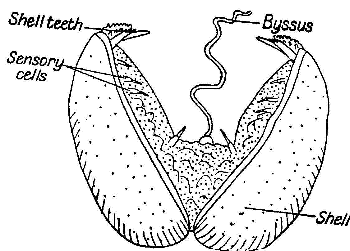
There is also a further link between fish and mollusc. The mussels produce eggs of their own which are retained in a special brood pouch for up to 9 months. Here they are also fertilised by sperms from a nearby male coming in with the feeding current. During their time in the pouch the eggs develop into a special larva called a glochidium. These get released into the water where the lucky ones come into contact with a fish. Small shell teeth on both bi-valves allow them to become attached where they burrow into the flesh and form a cyst. Over the next three months a miniature adult mussel develops which then drops off and leads a free existence.
After I had put the mussels into my tank the next morning I
spotted some of the glochidia. They were easily taken with a teat
pipette so I placed one under the stereo and then high power
compound microscope. rather comically they can be seen to open
and shut their shells rapidly. Between the shell valves is a
long, rather sticky looking thread, called the byssus. Presumably
this is helpful in sticking in pond weed and the like to give
more chance of attachment onto a passing fish.

Please report any Web problems
or offer general comments to the Micscape Editor,
via the contact on current Micscape Index.
Micscape is the on-line monthly
magazine of the Microscopy UK web
site at Microscopy-UK